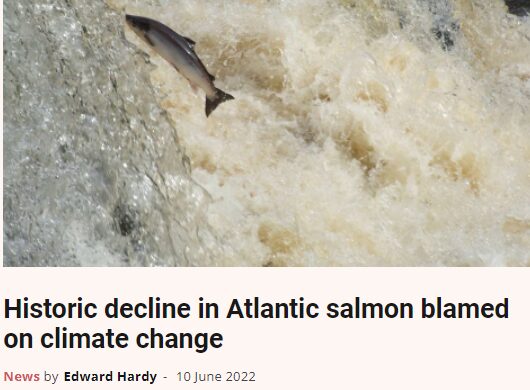 Villtur lax er í sögulegri lægð í Norður Atlantshafinu. Ástæðurnar eru áhrif loftslagsbreytinga á hafið og ýmis mannanna verk. Á sama tíma og náttúrulegar aðstæður villtu stofnanna eru að breytast með áður óþekktum hraða þrengir mannkyn að þeim með vaxindi mengun, virkjunum í ám og sjókvíaeldi í fjörðum. Tillitsleysið og yfirgangurinn gagnvart lífríkinu er taumlaus.
Villtur lax er í sögulegri lægð í Norður Atlantshafinu. Ástæðurnar eru áhrif loftslagsbreytinga á hafið og ýmis mannanna verk. Á sama tíma og náttúrulegar aðstæður villtu stofnanna eru að breytast með áður óþekktum hraða þrengir mannkyn að þeim með vaxindi mengun, virkjunum í ám og sjókvíaeldi í fjörðum. Tillitsleysið og yfirgangurinn gagnvart lífríkinu er taumlaus.
Eldislaxarnir deyja í milljónavís vegna vetrarsára og sjúkdóma sem spretta upp vegna þess aðbúnaðar sem dýrin þurfa að lifa við í sjókvíunum. Sjóvkíaeldisfyrirtækin slátra sýktum fiskum vegna veiru sem veldur blóðþorra og senda á neytendamarkað. Stjórnendur þeirra mæta svo í fjölmiðla og segja að áfram eigi að stunda þessar glórulausu framleiðslu eftir að „firðirnir“ hafi verið hvíldi í von um að það dugi til þess hin banværa veira verði horfin úr umhverfinu.
Sjókvíaeldi er óboðleg aðferð við matvælaframleiðslu. Það skaðar umhverfið og lífríkið og fer hroðalega farið með eldisdýrin.
Salmon Business fjallar um málið:
„Researchers at the University of Southhampton have revealed that a change in climate conditions in the North Atlantic and human exploitation of salmon have combined to lead to a dramatic fall in the population of the fish.
“These results can help us understand some of the controls on salmon populations prior to and during major human exploitation,” Professor David Sear, the lead author of the study, stated, citing large-scale changes in marine habitats.
“This research benefited from state-of-the-art geochemistry which enabled us to fingerprint salmon abundance over hundreds of years. We show that climate has been an important influence of salmon numbers, which is very relevant today due to the speed of climate change,” Professor Melanie Leng, co-author of the study, added.
As part of the study, the scientists took samples from Loch Insh on the River Spey, measuring Marine Derived Nutrients (MDNs), giving an understanding of the historic population levels of salmon. Control lakes, with no exposure to salmon, were used to determine and compare background nutrient levels.
Atlantic salmon lay eggs in the gravels of headwater streams, with young fish living for a year or two in the area before migrating out to sea. They feed and grow into adults before eventually returning to the river to spawn and possibly die. The salmon eggs and carcasses are filled with marine nutrients which can be detected within sediment for hundreds of years.
The report constructed a 200-year record of both salmon derived nutrients and variations in climate conditions to reach its conclusion.“
